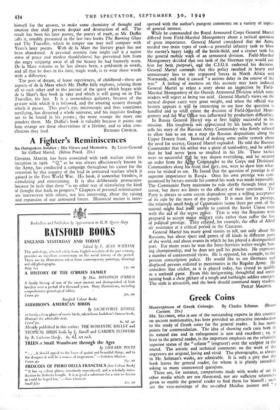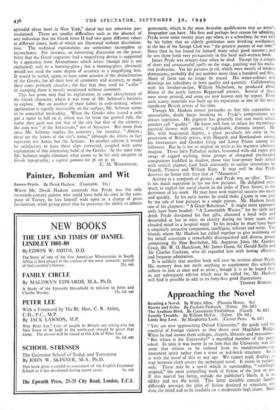Greek Coins
Masterpieces of Greek Coinage. By Charles Seltman. (Bruno
Cassirer. 21s.)
MR. SzurmArt, who is one of the outstanding experts in this country on ancient numismatics, has here provided an attractive introduction to the study of Greek coins for the general reader. It has many points for commendation. The idea of showing each coin both in its natural size and in enlargement is new and excellent ; so, at least to the general reader, is the important emphasis on the relatively superior status of the " celator " (engraver) over the sculptor in the round. The artistic and technical comments on the work of the engravers are original, loving and vivid. The photographs, as always in Mr. Seltman's works, are admirable. It is only a pity that the book leaves the general reader, for whom it is plainly intended, asking so many unanswered questions.
There are, for instance, comparisons made with works of art in other media which are not illustrated, nor are sufficient reference: given to enable the general reader to find them for himself ; such are the vase-paintings of the so-called Meidias painter and " splendid silver bowl in New York," dated but not otherwise par- ticularised. There are smaller difficulties such as the absence of any indication that the Greek letter H had two quite different values at different times, both of which arc illustrated without discrimina- tion. The technical explanations are sometimes incomplete or inconclusive. For instance, an interesting discussion on the possi- bility that the Greek engravers had a magnifying device is supported by a quotation from Aristophanes which refers (though this is not explained) only to a burning-glass ; but a burning-glass obviously would not need the same degree of accuracy as a magnifying lens. It would be useful, again, to have some account of the disinclination of the Greeks, for all their love of symmetry and accuracy, to make their coins perfectly circular ; the fact that they used no "collar" in stamping them is merely mentioned without comment.
This last point may find its explanation in some idiosyncrasy of the Greek character, which it was none of Mr. Seltman's business to explore. But on another of their habits in coin-making, whose explanation is equally inscrutable on the surface, Mr. Seltman seems to be somewhat misleading. When the Greeks who issued a coin put a name in full on it, which was far from the general rule, the name they gave was not that of the city but that of the citizens ; the coin was " of the Syracusans," not of Syracuse. But more than once Mr. Seltman implies the contrary ; for instance, " Ainion ; these are the letters of the city's name," although the letters in fact represent not Acnus but the Aenians. In another edition it would be satisfactory to have these slips corrected, coupled with some explanation of this interesting habit of the Greeks. At the same time Mr. Seltman might eliminate what seems to be his only misprint in Greek typography, a capital gamma for pi on p. 35.
C. M. WOODHOUSE.















































 Previous page
Previous page